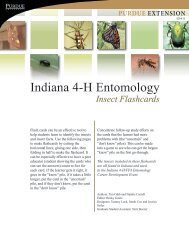Pink Gypsy Moth - aphis - US Department of Agriculture
Pink Gypsy Moth - aphis - US Department of Agriculture
Pink Gypsy Moth - aphis - US Department of Agriculture
Create successful ePaper yourself
Turn your PDF publications into a flip-book with our unique Google optimized e-Paper software.
forests (Baranchikov et al. 1995). Damage to chestnut resulted from an outbreak<br />
<strong>of</strong> L. mathura in areas <strong>of</strong> Kyonggi province, Korea (Lee and Lee 1996).<br />
Establishment <strong>of</strong> L. mathura in the <strong>US</strong> could also adversely impact trade. This<br />
insect has been proposed as an A2 quarantine pest in Europe, a status reflecting its<br />
limited presence (EPPO 2005). Potentially infested products within the <strong>US</strong> could<br />
become the focus <strong>of</strong> domestic or international quarantines.<br />
8. Potential Environmental Impact. Rating: High. In general, newly established<br />
species may adversely affect the environment by reducing biodiversity, altering<br />
forest composition, disrupting ecosystem function, jeopardizing endangered or<br />
threatened plants, degrading critical habitat, or stimulating use <strong>of</strong> chemical or<br />
biological controls. Lymantria mathura is likely to affect the environment in<br />
many <strong>of</strong> these ways.<br />
Because L. mathura is known to adversely impact forest productivity and cause<br />
tree mortality with repeated outbreaks, this insect has the potential to directly and<br />
indirectly alter the structure and function <strong>of</strong> forests. Lymantria mathura has the<br />
potential to directly affect forest composition because it has a broad host range<br />
and feeds on foliage <strong>of</strong> primarily deciduous tree species [see ‘Host Specificity’].<br />
Indirect effects stem from the arrival and establishment <strong>of</strong> secondary<br />
organisms/pathogens, such as opportunistic fungi.<br />
Synthetic insecticides are an option, but in many natural settings, complex terrain<br />
limits the feasibility <strong>of</strong> this option, especially over large areas. However, as has<br />
been observed with L. dispar, formulations <strong>of</strong> endotoxin from Bacillus<br />
thuringiensis (e.g, Bt-k) may be applied aerially to localized populations (Myers<br />
and Hosking 2002). Bt is generally considered host specific (Lacey and Siegel<br />
2000), but some exceptions have been noted especially after repeated applications<br />
(Lacey and Siegel 2000, Boulton 2004). Biological control is a much more likely<br />
option (Rosovsky 2001). Previous experience with gypsy moth demonstrates that<br />
predators, parasitoids, and pathogens might be introduced. In previous years,<br />
generalist agents (e.g., Compsilura concinata) were introduced, <strong>of</strong>ten with<br />
significant impacts on non-target species (reviewed in Syrett 2002). Current<br />
protocols for the screening <strong>of</strong> agents limit the likelihood <strong>of</strong> these severe impacts<br />
to non-target species (reviewed in Hoddle and Syrett 2002).<br />
Lymantria mathura may also jeopardize threatened or endangered plants.<br />
Appendix D summarizes state and federally listed threatened or endangered plant<br />
species (<strong>US</strong>DA 2001a) found within plant genera known to be hosts (or potential<br />
hosts) for L. mathura. Plants listed in Appendix D might be suitable hosts for<br />
L. mathura, and thus, could be adversely affected by this insect.<br />
9. Establishment Potential. Rating: Medium. Large areas <strong>of</strong> the United States<br />
are predicted to have a suitable climate for establishment <strong>of</strong> L. mathura, but this<br />
area is only moderate compared with the entire area <strong>of</strong> the country. The host<br />
CAPS PRA: Lymantria mathura 10
















